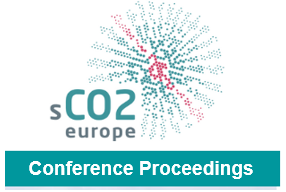Thermodynamic Analysis of a Reactive Particle-to-sCO2 Heat Exchanger for Recovering Stored Thermochemical Energy
The objective of this paper is to investigate the effect of offdesign supercritical carbon dioxide (sCO2) Brayton cycle operation on the thermodynamic performance of a heat exchanger/chemical reactor for transferring stored energy from hot, reduced, metal oxide particles into the power cycle. The device, termed an Energy Recovery Reactor (ERR), feeds gravity-driven particles through a bank of zigzag, finned, serpentine tubes containing sCO2 flowing in counterflow to the particles. Preheated air introduced at the bottom of the reactor flows through the zig-zag channels also in counterflow with the particles and parallel flow with the sCO2. The air supplies oxygen (O2) as the reactant to drive exothermic re-oxidation of particles. The air also functions as a heat transfer medium between the energized particles and sCO2.
In this study we develop a steady-state 1-D thermodynamic model of the ERR system. By defining controllable inputs such as inlet temperatures and flow rates of particles, air, and sCO2, the remaining state points are calculated based on mass and energy balances. With set flow rates of particles, adjusting the sCO2 cycle operating conditions (e.g., inlet temperature, flow rate, etc.) demonstrate how the performance of the ERR will change during off-design operation. Increasing the inlet temperature of the sCO2 while maintaining the required outlet temperature results in a smaller temperature lift and decreases the heat duty of the system as a whole. When the system runs with a constant particle flow rate, the total amount of chemical heat available is constrained based on the redox reaction. Therefore, adjusting the heat transfer to the sCO2 based on changes to the operating conditions results in changes to the recovery effectiveness and the ratio of sensible to chemical heat released by the particles. This model outputs the steady state operating conditions of the three domains within the reactor at various off-design conditions that are input to an existing segmented heat transfer model to calculate the temperature profiles and local heat transfer performance, which will be verified experimentally in future work.
Vorschau

Zitieren
Rechte
Nutzung und Vervielfältigung:
Dieses Werk kann unter einer Creative Commons Namensnennung 4.0 Lizenz (CC BY 4.0)
Creative Commons Namensnennung 4.0 Lizenz (CC BY 4.0)
genutzt werden.
